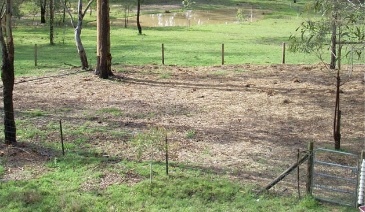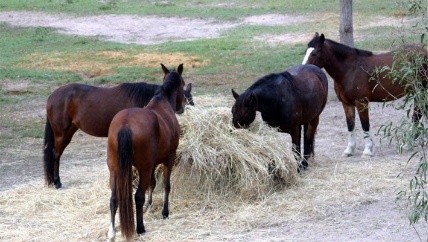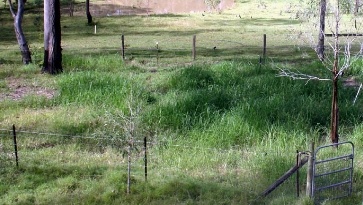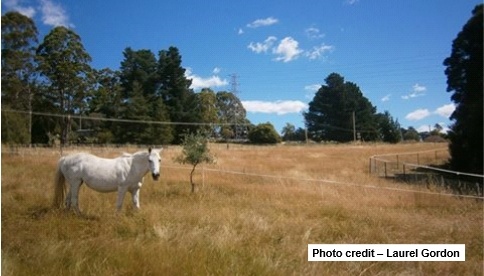Horses and the magic of mulching to improve land
Mar 21, 2021There is a shared vision of the ideal horse property, with horses grazing healthy pasture, good ground coverage, no bare soil, no mud, dust or weeds. But unfortunately, the land that horses are kept on does not usually live up to this ideal image.
The common land management problems with many horse properties
On many horse properties, the reality is bare soil - caused by horses standing around for hours at a time (usually in gateways) and overgrazing. There are often 'tracking lines' cased by horses repeatedly walking the same path to get to areas such as the water trough, also lots of bare areas of compacted soil, which quickly turn to mud in wet weather and dust in dry weather.
These compacted, bare soil areas 'invite' weeds into the property because nature does not like bare soil. Nature will always attempt to cover bare soil with plants. These plants are usually weeds in the first place because weeds are great opportunists and are often the only plants that can grow in compacted, degraded soil.
By the way, not all plants we consider weeds are 'bad' or harmful. Many can be beneficial, but more on that in another article/video.
Mulching is the solution to some of the common problems with land used for horsekeeping
There is a straightforward fix for bare degraded soil: mulching. Mulching is an easy and effective way to rapidly improve soil and create the right conditions for more desirable plants to grow.
Mulching is a simple strategy for improving pasture that does not involve using heavy machinery to plough and reseed, for example. This means that the soil is left undisturbed (very important). You protect the soil with mulch and let nature do the rest.

You can see an area here that has been mulched. The soil is protected from heat extremes until the mulch decomposes and new plants grow.
Mulching has many benefits on land used for horses
Mulching insulates the soil from the extremes of the weather. In winter, mulch keeps the soil warm, and in summer, mulch keeps the soil cool. In dry times of the year, it retains moisture in the soil; in wet times of the year, it slows the water down (reducing flash flooding).
Mulching protects all the creatures and microorganisms (beetles, fungi, etc.) that live in the soil from these temperature extremes. These creatures and microorganisms are vital for soil health but cannot cope with these extreme temperature ranges. So mulching keeps the temperature of the soil more constant and protects everything that lives in it.
Mulching traps moisture. If you look at the image below, the top of the mulch is dry, but it is moist and dark underneath where it trapped the moisture, and the microorganisms, the bugs, and the fungi, could do their vital work protected from the elements. This mulch had been down for about 18 months during a scorching, dry period in Australia, so there had been no rain for many months.

Mulching traps moisture; see how the top of the mulch is dry, but underneath is moist and dark.
How can you learn more about horses, land management and the environment?
Start by signing up for the free mini-course about Horses, pasture and
grazing www.equiculture.net/equiculture-free-mini-course
Mulching helps to control weeds. In the same way as mulch in a garden, mulch in a pasture helps keep weeds at bay. Mulch can also suppress the growth of weeds already in a pasture by smothering them.
In the image below, the pasture is full of weeds or was full of weeds. You can see that mulching has been very effective because new grass is growing through the mulch, and there are no weeds in that area. The mulch has smothered any weeds and allowed the grass to grow and get ahead of the weeds.

You can see that mulching has been very effective because new grass is growing through the mulch, and there are no weeds in that area.
Mulching provides very much-needed organic matter. Land where horses are kept is often lacking in organic matter due to poor land management in the past. Mulch decomposes and adds vital organic matter to the soil.
Mulching provides a habitat for other essential creatures in the soil, such as earthworms. Earthworms cannot work in bare, compacted, dry soil. So, this moist, protected environment allows them to do their essential work.
Two ways to mulch land used for horses: mulching using horses to help you and mulching by placing materials directly onto bare soil
Mulching using horses and round bales of hay (round bale mulching)
This is done by feeding horses hay (large round bales of hay work best) in areas that need to be mulched. It works well if you have three or four horses per round bale (if you do not feed round bales, you will also get good results using hay from small square bales, but large round bales work particularly well for mulching using horses).
In the image below, four horses have access to one round bale. If you look behind them, you can see bare patches of soil; this is what the whole area was like before: bare patches and compacted soil, not growing much pasture.

Looking behind the horses, you can see bare patches of (sandy) soil; this is what the whole area was like before: bare patches not growing much pasture.
Is it wasteful to feed round bales of hay to horses?
A round bale is placed in with the horses, and they get on with eating it. It appears that they 'waste' some, but at Equiculture, we do not consider this as 'wastage' but rather an investment because it covers the soil with invaluable mulch.
In financial terms, a round bale usually costs about a third less than the equivalent weight of small square bales. So, if they 'waste' a third, you've broken even anyway.
However, it is not 'wasted' because it is protecting the soil and starting to improve the soil, so it makes good economic sense.
Obtain round bales containing plant species you want to grow in your pasture because the seeds in the hay will do just that.
Is it dangerous to feed round bales of hay to horses?
Something you do need to watch for is some of the hay can go mouldy in wet or humid conditions if it takes the horses a while to eat the round bale. You will not be able to mulch using a large round bale if you only have one small pony, but three or four average-sized horses will get through a round bale in five or six days, so there isn't usually time for it to go mouldy, but do watch out in wet, humid conditions.
So you feed the horses the round bale, they eat the round bale, and when they have finished, you put another round bale on the next bare area.
Once you have fed round bales in all bare patches and the whole area is covered, remove the horses and let the mulch break down. The mulch will not start to break down until there is rain, so if you have a prolonged dry period, it's OK to go around that area two or three times with hay and layer it on even thicker.
When it rains and the moisture builds up in the mulch, it begins to break down rapidly. That is why you remove the horses because you don't want them walking around in that area, churning it up and uprooting any new grass plants starting to grow.

Once the mulch containing seeds decomposes, you get this happening. You can see the grass growing. So we have gone from bare soil to this by feeding horses round bales in the area.
Keep horses off the area until the new grass plants are very well established. You should be able to get hold of a plant, twist and tug, and the leaves should break off in your hand. You should carry out this test on any new pasture before allowing animals to graze it.
That's the magic of mulching; it is so effective, but remember, once it starts to get wet and starts to break down, you need to get the horses out of there because they will churn it up and damage any new plants.
Is there a manure management issue when mulching with hay and horses?
Another benefit is that they drop manure in that area. Manure is a bonus! Manure is fertiliser and adds more organic material to the soil.
Remember, most gardeners love horse manure for its organic content and the nutrients it adds to the soil.
Don't be frightened of the horses eating around the manure (and therefore picking up parasites) because they're not going to do that; they eat the hay, and when the hay gets down to a certain level, they signal to you to bring some more out (usually by standing at the gate and staring at you). They then move on to the fresh bale.
Mulching by placing materials directly onto bare soil
In this case, the horses do not have access to an area while it is being mulched.
You can use old hay (it doesn't matter how old or mouldy the hay is if the horses do not have access to it), shavings, manure, and wood chips from the local council, in fact, anything at all, rather than leaving the soil bare.
So, if you see a patch of bare soil, you need to cover it with something 'organic' if possible. By 'organic', we mean something that will decompose and protect the area (and eventually turn into new soil).
You can keep horses off mulched areas by erecting a temporary electric fence to keep them out.
A bonus of using old hay is that it may contain thousands of grass seeds (depending on the condition of the hay, it may have rotted to the point where the seeds are no longer viable). So as well as providing a perfect environment for successful germination, you are reseeding the area.
So, you get 'free' grass seeds and provide an environment where they can grow, so it's a win-win situation.
It is a good idea to keep a bag of desirable pasture seeds handy, seeds of plants that will add to and compliment the pasture species you already have.
Once the mulch starts to break down, scatter pasture seeds (by hand) in the decomposing mulch. This way, you get a more biodiverse sward, which is what you should always aim for.
Mulching land where horses are kept, in action
There are many benefits of mulching when combined with THE EQUICENTRAL SYSTEM. In a nutshell, The Equicentral System is where the pastures are used in rotation. A surfaced area is provided for the horses to carry out behaviours other than grazing. The horses can always take themselves to this surfaced area (because the gate leading to it is always open). So the surfaced area is used for water, any supplementary feed they may receive, hay and 'loafing'.
Here you can see an overgrazed pasture and bare patches of soil, and it needs some TLC to get it back up to how it should be. Applying mulch and using Equicentral System practices simultaneously has resulted in a fantastic outcome. This pasture has been turned around using old hay and better horse and land management. These images were taken in Tasmania, but mulching works equally well in the drier parts of Australia (and indeed in any country).


These images are from South Australia – what a result!
Mulching with horses works equally well in wet conditions, in fact, in all climates. Watch the short video with this post for more examples in various climates.
Mulching on a horse property - more benefits
Mulching is great for problem areas such as slopes/hillsides. A barrier is created by mulching across a hill, and when it rains, it slows the water, and the water has longer to be absorbed into the ground.
Mulching helps you to retain topsoil. Mulch traps any soil and nutrients further up the land, reducing nutrients and soil from being washed away (either to a nearby property or, worse, into the waterways). Think about the importance of this. You do not want your precious topsoil ever to leave your land. Again, mulch improves pasture by stopping the soil and nutrients from being washed away, keeping them on the land where they are meant to be.

Mulching is also great for rocky or treed areas. In this image, you can see the area on the right has good soil and can grow pasture; however, the area on the left was just rocks and sand. By mulching this area, using round bales to mulch up and down this area over several months, and then pulling the horses out of there once the weather changed and the mulch started to break down, new soil was created. As the mulch decomposes, it creates new soil and grows new pasture.
Never underestimate the magic of mulching, especially in problem areas.
Mulching on a horse property - conclusions
Mulching:
- Protects the soil and everything living in it from temperature extremes.
- Adds organic matter to the soil; this eventually recreates more soil.
- Provides additional nutrients.
- Adds seeds (if using hay).
- Creates a suitable environment for new plants to grow.
- Can help to control weeds.
- Reduces mud/dust.
- Holds and can redirect water and reduce flash flooding.
Mulching is a win-win scenario; using hay or discarded materials is an effective and inexpensive method of soil protection, soil improvement and pasture improvement.
Learn how to manage your land and horses better, in a way that is good for biodiversity, the wider environment, soil health, horse health, and their welfare etc.
Start by signing up for the free mini-course about Horses, pasture and
grazing www.equiculture.net/equiculture-free-mini-course


















